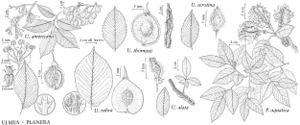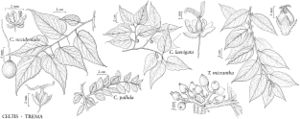Difference between revisions of "Ulmaceae"
FNA>Volume Importer |
imported>Volume Importer |
||
| (7 intermediate revisions by 2 users not shown) | |||
| Line 13: | Line 13: | ||
}}<!-- | }}<!-- | ||
| − | --><span class="statement" id="st- | + | --><span class="statement" id="st-undefined" data-properties=""><b>Trees </b>or shrubs, deciduous (sometimes tardily deciduous in <i>Ulmus</i>). <b>Bark</b> smooth to deeply fissured or scaly and flaky; sap watery. <b>Leaves</b> alternate [opposite], distichous [or not], simple; stipules present; petiole present. <b>Leaf</b> blade: base often oblique, margins entire or serrate, crenate, or toothed; venation pinnate to palmate-pinnate. <b>Inflorescences</b> axillary, cymes, racemes, fascicles, or flowers solitary, arising from branchlets of previous season (e.g., <i>Ulmus</i>) or of current season (e.g., <i>Celtis</i>). <b>Flowers</b> bisexual or unisexual, staminate and pistillate on same [different] plants; sepals persistent, (1-)5(-9), connate [distinct], imbricate or valvate; petals absent; stamens usually as many as calyx lobes, hypogynous, opposite calyx lobes, erect in bud; filaments free or arising from calyx tube, distinct, curved or sigmoid in bud; anthers 2-locular, dehiscence longitudinal; pistils 1, 2(-3)-carpellate; ovary 1(-2)-locular; ovules 1 per locule, pendulous from apex of locule, anatropous or amphitropous; styles (1-)2, distinct, receptive stigmatic area decurrent on distal inner margin of style branch. <b>Fruits</b> fleshy drupes, samaras, or nutlike. <b>Seeds</b> 1; arils absent; endosperm absent to scanty, consisting of 1 layer of thick-walled cells; embryo straight or curved.</span><!-- |
-->{{Treatment/Body | -->{{Treatment/Body | ||
| − | |distribution=Tropical and north temperate regions | + | |distribution=Tropical and north temperate regions. |
|discussion=<p>Genera ca. 18, species ca. 150 (4 genera, 19 species in the flora).</p><!-- | |discussion=<p>Genera ca. 18, species ca. 150 (4 genera, 19 species in the flora).</p><!-- | ||
--><p>Plants of this family are wind-pollinated (anemophilous).</p><!-- | --><p>Plants of this family are wind-pollinated (anemophilous).</p><!-- | ||
--><p>Ulmaceae are frequently divided into two subfamilies, Ulmoideae and Celtoideae; they are sometimes separated into two families, Ulmaceae and Celtidaceae (I. A. Grudzinskaya 1965). These subfamilial or familial distinctions are supported by flavonoid chemistry (D. E. Giannasi and K. J. Niklas 1977; D. E. Giannasi 1978), pollen morphology (M. Zavada 1983), and some anatomic structures (E. M. Sweitzer 1971). Typically the Ulmoideae have flavonols, strictly pinnately veined leaves, and dry fruits; the Celtoideae have glycoflavones, pinnipalmately veined leaves, and drupaceous fruits. Some genera (e.g., Zelkova, with pinnately veined leaves and drupaceous fruits) are intermediate, and various authors place them in different subfamilies.</p><!-- | --><p>Ulmaceae are frequently divided into two subfamilies, Ulmoideae and Celtoideae; they are sometimes separated into two families, Ulmaceae and Celtidaceae (I. A. Grudzinskaya 1965). These subfamilial or familial distinctions are supported by flavonoid chemistry (D. E. Giannasi and K. J. Niklas 1977; D. E. Giannasi 1978), pollen morphology (M. Zavada 1983), and some anatomic structures (E. M. Sweitzer 1971). Typically the Ulmoideae have flavonols, strictly pinnately veined leaves, and dry fruits; the Celtoideae have glycoflavones, pinnipalmately veined leaves, and drupaceous fruits. Some genera (e.g., Zelkova, with pinnately veined leaves and drupaceous fruits) are intermediate, and various authors place them in different subfamilies.</p><!-- | ||
| − | --><p>In this treatment Ulmus and Planera are considered part of the subfamily Ulmoideae; Celtis and Trema are in subfamily Celtoideae. Zelkova serrata is widely cultivated as an ornamental tree in North America, but it is not known to be naturalized in the flora. Chemical similarities between subfamilies include the presence of proanthocyanins with some tannins and scattered mucilaginous cells or canals. Additionally, members of the family share a strong tendency toward mineralization of the cell walls with calcium carbonate or silica and possess solitary or clustered crystals of calcium oxalate.</p><!-- | + | --><p>In this treatment <i>Ulmus</i> and <i>Planera</i> are considered part of the subfamily Ulmoideae; <i>Celtis</i> and <i>Trema</i> are in subfamily Celtoideae. Zelkova serrata is widely cultivated as an ornamental tree in North America, but it is not known to be naturalized in the flora. Chemical similarities between subfamilies include the presence of proanthocyanins with some tannins and scattered mucilaginous cells or canals. Additionally, members of the family share a strong tendency toward mineralization of the cell walls with calcium carbonate or silica and possess solitary or clustered crystals of calcium oxalate.</p><!-- |
--><p>Ulmaceae include trees and shrubs of horticultural importance.</p> | --><p>Ulmaceae include trees and shrubs of horticultural importance.</p> | ||
|tables= | |tables= | ||
| Line 81: | Line 81: | ||
-->{{#Taxon: | -->{{#Taxon: | ||
name=Ulmaceae | name=Ulmaceae | ||
| − | |author=Susan L. Sherman-Broyles; William T. Barker; Leila M. Schulz | + | |author=Susan L. Sherman-Broyles;William T. Barker;Leila M. Schulz |
|authority=Mirbel | |authority=Mirbel | ||
|rank=family | |rank=family | ||
| Line 89: | Line 89: | ||
|family=Ulmaceae | |family=Ulmaceae | ||
|illustrator=John Myers | |illustrator=John Myers | ||
| − | |distribution=Tropical and north temperate regions | + | |illustration copyright=Flora of North America Association |
| + | |distribution=Tropical and north temperate regions. | ||
|reference=barker1986a;elias1970a;giannasi1977a;giannasi1978a;grudzinskaya1965a;sweitzer1971a;zavada1983a | |reference=barker1986a;elias1970a;giannasi1977a;giannasi1978a;grudzinskaya1965a;sweitzer1971a;zavada1983a | ||
|publication title= | |publication title= | ||
|publication year= | |publication year= | ||
|special status= | |special status= | ||
| − | |source xml=https:// | + | |source xml=https://bitbucket.org/aafc-mbb/fna-data-curation/src/2e0870ddd59836b60bcf96646a41e87ea5a5943a/coarse_grained_fna_xml/V3/V3_886.xml |
| − | |||
| − | |||
| − | |||
| − | |||
| − | |||
| − | |||
| − | |||
| − | |||
| − | |||
| − | |||
| − | |||
| − | |||
| − | |||
| − | |||
| − | |||
| − | |||
| − | |||
| − | |||
| − | |||
| − | |||
| − | |||
| − | |||
| − | |||
| − | |||
| − | |||
| − | |||
| − | |||
| − | |||
| − | |||
| − | |||
| − | |||
| − | |||
| − | |||
| − | |||
| − | |||
| − | |||
| − | |||
| − | |||
| − | |||
| − | |||
| − | |||
| − | |||
| − | |||
| − | |||
| − | |||
| − | |||
| − | |||
| − | |||
| − | |||
| − | |||
| − | |||
| − | |||
}}<!-- | }}<!-- | ||
-->[[Category:Treatment]] | -->[[Category:Treatment]] | ||
Latest revision as of 21:52, 5 November 2020
Trees or shrubs, deciduous (sometimes tardily deciduous in Ulmus). Bark smooth to deeply fissured or scaly and flaky; sap watery. Leaves alternate [opposite], distichous [or not], simple; stipules present; petiole present. Leaf blade: base often oblique, margins entire or serrate, crenate, or toothed; venation pinnate to palmate-pinnate. Inflorescences axillary, cymes, racemes, fascicles, or flowers solitary, arising from branchlets of previous season (e.g., Ulmus) or of current season (e.g., Celtis). Flowers bisexual or unisexual, staminate and pistillate on same [different] plants; sepals persistent, (1-)5(-9), connate [distinct], imbricate or valvate; petals absent; stamens usually as many as calyx lobes, hypogynous, opposite calyx lobes, erect in bud; filaments free or arising from calyx tube, distinct, curved or sigmoid in bud; anthers 2-locular, dehiscence longitudinal; pistils 1, 2(-3)-carpellate; ovary 1(-2)-locular; ovules 1 per locule, pendulous from apex of locule, anatropous or amphitropous; styles (1-)2, distinct, receptive stigmatic area decurrent on distal inner margin of style branch. Fruits fleshy drupes, samaras, or nutlike. Seeds 1; arils absent; endosperm absent to scanty, consisting of 1 layer of thick-walled cells; embryo straight or curved.
Distribution
Tropical and north temperate regions.
Discussion
Genera ca. 18, species ca. 150 (4 genera, 19 species in the flora).
Plants of this family are wind-pollinated (anemophilous).
Ulmaceae are frequently divided into two subfamilies, Ulmoideae and Celtoideae; they are sometimes separated into two families, Ulmaceae and Celtidaceae (I. A. Grudzinskaya 1965). These subfamilial or familial distinctions are supported by flavonoid chemistry (D. E. Giannasi and K. J. Niklas 1977; D. E. Giannasi 1978), pollen morphology (M. Zavada 1983), and some anatomic structures (E. M. Sweitzer 1971). Typically the Ulmoideae have flavonols, strictly pinnately veined leaves, and dry fruits; the Celtoideae have glycoflavones, pinnipalmately veined leaves, and drupaceous fruits. Some genera (e.g., Zelkova, with pinnately veined leaves and drupaceous fruits) are intermediate, and various authors place them in different subfamilies.
In this treatment Ulmus and Planera are considered part of the subfamily Ulmoideae; Celtis and Trema are in subfamily Celtoideae. Zelkova serrata is widely cultivated as an ornamental tree in North America, but it is not known to be naturalized in the flora. Chemical similarities between subfamilies include the presence of proanthocyanins with some tannins and scattered mucilaginous cells or canals. Additionally, members of the family share a strong tendency toward mineralization of the cell walls with calcium carbonate or silica and possess solitary or clustered crystals of calcium oxalate.
Ulmaceae include trees and shrubs of horticultural importance.
Selected References
Illustrations
Key
| 1 | Leaf blade pinnately veined; fruits dry, nutlike or samaras. | > 2 |
| 1 | Leaf blade palmately veined at base, pinnately veined over remainder of blade; fruits drupes. | > 3 |
| 2 | Flowers bisexual; fruits samaras. | Ulmus |
| 2 | Flowers normally unisexual, inflorescences usually with a few bisexual flowers; fruits nutlike. | Planera |
| 3 | Leaf blade entire or serrate to ca. 3/4 length; flowers solitary or in few-flowered clusters; drupes 1. | Celtis |
| 3 | Leaf blade crenate to serrate for entire length; flowers 12-20, in cymes. | Trema |

